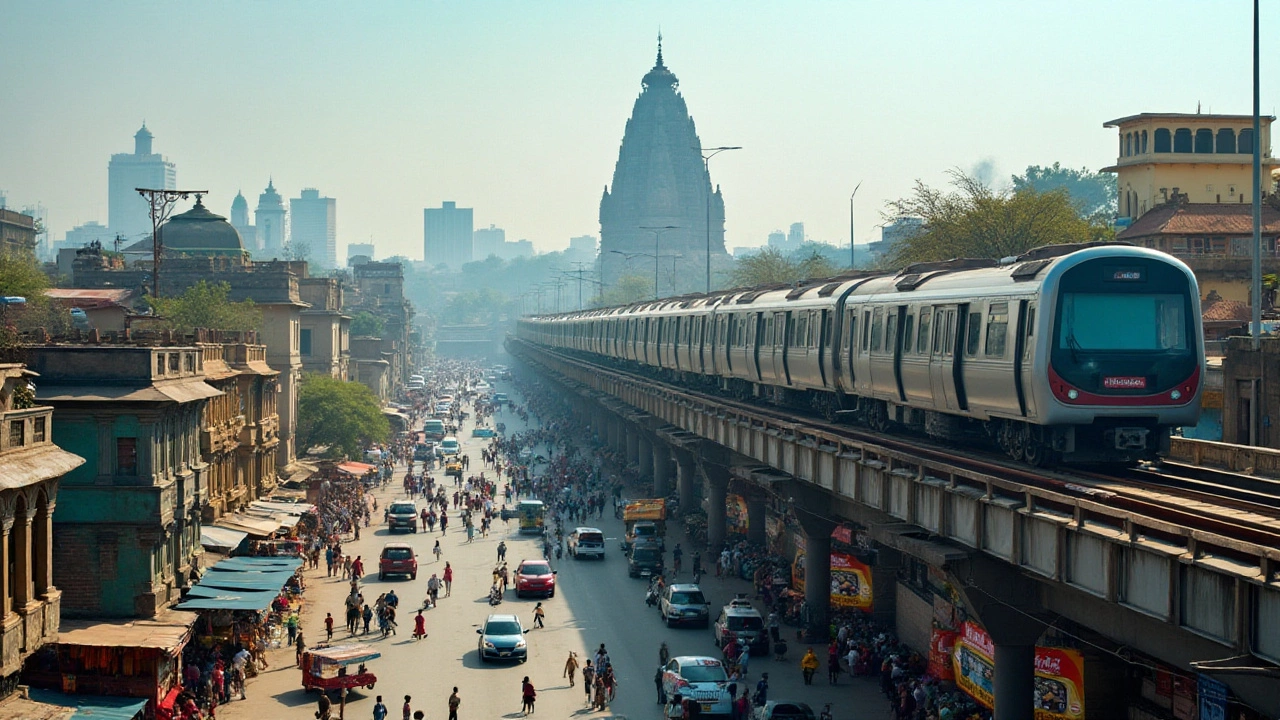The metro, a moniker for metropolitan or rapid transit systems, is a familiar sight in bustling cities worldwide. These networks play a crucial role in linking diverse neighborhoods, sprawling suburbs, and central urban areas, transforming the way people commute daily. The sleek trains, often sliding underground or occasionally rising above the cityscape, bring an ease of movement that buses and cars simply can't match in congested environments.
But what exactly makes a transport system a 'metro'? It's not just about the speed or the tracks it glides over; it's a whole infrastructure designed for efficiency and high passenger volumes. Recognizing a metro's characteristics helps us understand its influence, especially regarding property values in its vicinity. This piece dives into this intricate world, revealing how metros shape urban landscapes and make nearby properties tantalizing prospects for investors and residents alike.
- What Defines a Metro System?
- The Evolution of Metro Networks
- Impact on Nearby Real Estate
- Benefits for Urban Development
- Investing in Property Near a Metro
What Defines a Metro System?
Metros, often heralded as the golden threads weaving the urban tapestry of major cities, are poised as icons of rapid urban transport. A metro system is essentially a high-capacity public transit service that offers efficient, speedy travel within urban and suburban locales. These systems stand out through their frequent services and capability to handle significant volumes of passengers, providing an indispensable backbone to city-based commuting.
One hallmark of a metro definition is its tracks—most often separated from other traffic routes, typically built underground, though some systems boast elevated tracks or at-grade lines. The intricate tunnel networks are a testament to human engineering, balancing the dual needs of minimizing surface disruption while optimizing connectiveness across the city's fabric. For instance, the Paris Métro famously showcases this subterranean architecture, with roots tracing back to the early 1900s and serving millions daily.
In defining a metro, another pivotal element is the reliability and frequency of its services. Unlike traditional train setups, metros operate on a scheduled timetable, ensuring minimal wait times, an aspect critical for urban dwellers hurtling through their bustling lives. The Tokyo Metro, esteemed globally, exemplifies this precision with trains arriving mere minutes apart, a crucial factor that sustains its high ridership.
Metro Systems: More Than Just Tracks
A major factor distinguishing metros is the technological integration that underpins their operation. Modern systems incorporate advanced signaling technology, enabling trains to operate closer together, enhancing safety and efficiency. Moreover, the infrastructure often expands into expansive networks, linking city centers with distant suburbs seamlessly. This aspect not only feathers the nests of city professionals but opens opportunities for those living on the edge of urban sprawl, improving accessibility without the necessity of personal vehicles. It's therefore not surprising that real estate near metro stations often sees an uptick in demand, as accessibility is a prime factor influencing property values.
A fascinating insight into metro systems comes from historical and contemporary analysts. As the urban studies scholar Peter Hall once noted,
The invention of the metro was not just about technological advances; it was about reshaping city life.This ideology is palpable when you consider how many cities, including London and New York, have morphed around their metro networks, with these arteries feeding into busy concourses that pulse with daily life.
Metros aren't merely transport systems—they're lifelines projecting cities into future development and growth. The burgeoning expansion of metro networks worldwide signifies their critical role in urban planning, promoting environment-friendly travel solutions that alleviate traffic congestion and reduce urban pollution. As cities worldwide strive for greener footprints, metro systems are likely to continue playing an undisputed role, cementing their place as the steel sinews of our cities' futures. With this understanding, it's easy to appreciate why residents and investors are drawn to properties within a handshake distance of their local metro station.
The Evolution of Metro Networks
The journey of metro systems from their inception to what we see today is a fascinating tale of innovation, necessity, and urban growth. The first metro that hit the tracks was the London Underground, which opened its doors to the public in 1863. This system, fondly known as the Tube, was a bold step forward, trying to tame the chaotic traffic of Victorian London streets. Operating initially with steam locomotives, London's metro network set the blueprint for future urban rapid transit systems. As technology progressed, electrification became the norm, offering quieter, cleaner, and more efficient transportation solutions.
Paris soon followed in the late 19th century, with its intricate metro lines that served as a canvas for art nouveau architecture. By the early 20th century, metro systems took off worldwide, reaching places like Tokyo, New York, and Moscow, each adapting the concept to their unique urban challenges. The Tokyo subway, for instance, became a marvel of punctuality and efficiency, addressing the needs of one of the world's busiest cities. It was during this time that technological advances, like automated ticketing systems and improved signaling techniques, significantly enhanced the speed and safety of metro networks.
These networks didn’t just grow; they transformed urban landscapes. As metros expanded into suburbs, they brought with them increased real estate accessibility and development opportunities. In many cities, metro expansion was a catalyst for suburban growth, leading to new residential, commercial, and retail spaces. Interestingly, a recent study by the Urban Land Institute pointed out that properties near metro stations often experience a rise in value due to the accessibility they provide, which reflects the profound economic impact metros have.
"Metro systems are not merely about transportation; they are fundamental to city infrastructure and development," remarks Dr. Lucy Cartwright, an urban planning historian. "They influence everything from economic growth to social dynamics and environmental health."
As we look into the current era, we're seeing a shift towards more sustainable and smart metro systems. Innovations such as automated trains, smart ticketing via mobile apps, and eco-friendly stations equipped with solar panels illustrate the future of metros embracing green technology and efficiency. The development of networks like the Riyadh Metro showcases the global push towards modernized infrastructures that prioritize sustainability without sacrificing transit efficiency.
The development and adaptation of metros are ongoing reflections of global urbanization trends. Modern metro systems often integrate with other modes of public transport, such as buses and bikes, forming interconnected transit hubs. This intermodality not only eases daily commutes for millions but also helps cities reduce their carbon footprints. Chester Greene, a leading urban systems researcher, highlights these benefits, saying, "Incorporating metros within a larger multimodal transportation network is crucial for tackling both congestion and environmental issues in metropolises worldwide."

Impact on Nearby Real Estate
Metropolitan transit systems, commonly referred to as metros, have a profound effect on the real estate landscape of the areas they serve. Their influence is most keenly observed through the surge in property values, a phenomenon attributed to the enhanced accessibility and convenience they bring. Properties in proximity to metro stations often witness a significant increase in demand due to the ease of commuting they offer. This trend is consistent across major urban centers worldwide, where proximity to a metro can add a hefty premium to real estate prices.
The appeal lies not just in the reduced travel time but also in the potential lifestyle upgrades. Areas served by a metro often experience further development in amenities, including retail outlets, entertainment centers, and improved public services. This, in turn, spurs interest from homebuyers and investors looking to capitalize on the blend of accessibility and urban living. With properties near metro stations typically appreciating at faster rates, they represent a lucrative opportunity for savvy investors aiming to maximize return on investment.
Interestingly, a study from the Urban Land Institute noted that properties located within a half-mile radius of a metro station can increase in value by up to 10-20%. The convenience factor becomes a major selling point for both residential and commercial properties. Businesses benefit from the increased footfall and visibility, prompting higher commercial rental yields. Meanwhile, residential areas see an influx of tenants willing to pay more for the privilege of a short, hassle-free commute. This is succinctly echoed in a statement by a senior analyst at Global Real Estate Group: "The metro doesn't just move people; it shifts economic landscapes. Properties around stations are prime real estate, tapped into the city's lifeline."
While the positive impact on property values is well-documented, it's crucial to understand the full implications. The surge in demand can lead to increased housing prices, sometimes contributing to gentrification and posing challenges for long-standing residents as affordability becomes a pressing issue. Cities need to balance development with inclusivity, ensuring that existing communities can thrive alongside new investments. Measures such as zoning adjustments and affordable housing initiatives can play a pivotal role in mitigating potential negative impacts.
A striking example of the metro's impact on property can be seen in Tokyo. The development of the extensive metro network there is closely tied to real estate trends. As each new line was added, neighborhoods previously considered peripheral suddenly found themselves at the center of thriving developments. The convenience of the metro effectively reshapes these areas, integrating them into the urban core and elevating their status within the city’s housing market. Such transformations exemplify the symbiotic relationship between urban transit systems and real estate growth, a dynamic observed globally as cities continue to expand their transit infrastructures.
Benefits for Urban Development
The introduction of a metro system can catalyze incredible changes in urban areas, primarily by enhancing connectivity and accessibility. Cities like London, New York, and Tokyo demonstrate how efficient metro networks are pivotal to economic vitality and growth. These systems allow residents to traverse vast distances quickly, making it feasible to work far from where they live, fostering employment flexibility, and reducing pressure on housing in central areas. Improved access to different parts of the city can transform previously neglected neighborhoods into bustling communities, attracting new businesses and residents.
Moreover, with a strong metro network, cities can aim for densification—a sustainable urban planning goal. Increased density around metro stations can spur development with a mix of residential, commercial, and recreational spaces. This 'transit-oriented development' seeks to create self-sustaining communities where people can live, work, and play without necessarily relying on cars. Emphasizing public transportation reduces the urban carbon footprint, contributing to cleaner air and less congested streets. As populations grow, especially in fast-expanding cities across Asia and Africa, metros emerge as essential instruments in managing urban sprawl responsibly.
"Metropolitan areas with robust transit systems have a competitive edge in attracting both talent and investment," states John Green, an urban planner with over two decades of experience. "Developers are keenly aware that proximity to a metro not only boosts property value but also enhances quality of life," he adds.
A metro line's strategic placement can also draw significant commercial interest. Retail businesses flourish in areas with high foot traffic, often provided by metro stations. For instance, cities like Paris have embraced underground shopping malls connected to their metro systems, capitalizing on the heavy usage. This integration encourages people to spend time and money in commercial districts, significantly aiding local economies. Importantly, metros also support tourism by linking major attractions seamlessly, making them accessible without the need for taxis or rental cars.
The ripple effects of a new metro line sometimes reach beyond immediate vicinity. Infrastructure improvements in a city due to metro expansion can include better roads, enhanced public spaces, and upgraded utilities. Such enhancements benefit all residents, elevating the city's profile. With the world moving towards sustainable living, metros provide an environmentally friendly alternative to gas-guzzling commutes. Electric trains are key to this shift, using less electricity per passenger compared to automobile dependence. For example, a study from the American Public Transportation Association highlights that a single person commuting by rail instead of driving can reduce daily carbon emissions by 214 pounds.
The socio-economic benefits of metro systems are profound, nurturing cultural exchange by connecting diverse communities. They enable residents to participate in different cultural and social activities, fostering a more unified city dynamic. Events, business hubs, and educational institutions become accessible to a broader audience, promoting inclusivity. While the initial investment in metro infrastructure is significant, the return on investment often manifests in a city's increased attractiveness as a hub of opportunity and innovation.

Investing in Property Near a Metro
Investing in real estate near a metro often presents a golden opportunity for those looking to enhance their portfolio with properties that promise robust value growth. One of the greatest advantages of purchasing property in proximity to a metro station is the undeniable appeal of convenience—the lifeblood of urban living. The reliable accessibility offered by such locations serves as a magnet not only for prospective homeowners but also for a myriad of renters who prioritize swift and efficient commuting options. This constant demand ensures a steady stream of potential tenants, and subsequently, a reliable rental income for property owners.
The surge in property prices near metro stations is well-documented. A study by the National Association of Realtors found that homes within walking distance to public transit, including metros, were valued significantly higher than those situated further away. The reason for this boost is twofold: firstly, the reduced commute time becomes a saving grace for city dwellers; and secondly, the allure of easier access to city amenities can enhance lifestyle dynamics enormously. It’s a dynamism that cities like Tokyo, Paris, and New York have demonstrated perfectly over decades, where the proximity to a subway line translates directly into higher property premiums.
According to urban planning expert Dr. Lisa Fischer, "Living close to a metro not only saves time but elevates the quality of life by reducing stress associated with traffic and long commutes."
Investment strategies should consider the long-term benefits of such properties. The foresight of acquiring real estate in developing areas expected to soon host a metro station can lead to impressive returns as infrastructure gets established and promises of convenience become reality. The process often includes the catalytic effect of increased retail and employment opportunities due to heightened foot traffic, which can drive local economic growth and increase property values further.
However, savvy investors must exercise diligence. One should analyze key factors such as the frequency of metro services, the connectivity to crucial urban hubs like business districts, and upcoming infrastructural developments. Anticipate potential growth by looking at city planning documents or upcoming urban development plans, which may indicate future metro expansions. By doing so, investors not only mitigate risks associated with their investments but also strengthen their potential for future profits.
The real estate landscape can be unpredictable, but properties near metro stations have shown a consistent trend towards appreciation in value. Whether it is due to increased desirability for renters and buyers or the economic stimulation associated with enhanced connectivity, investing near a metro can indeed be a strategically sound decision. In the ever-evolving world of real estate, this trend is unlikely to fade, making metro-adjacent properties a wise investment choice for the forward-thinking individual.





